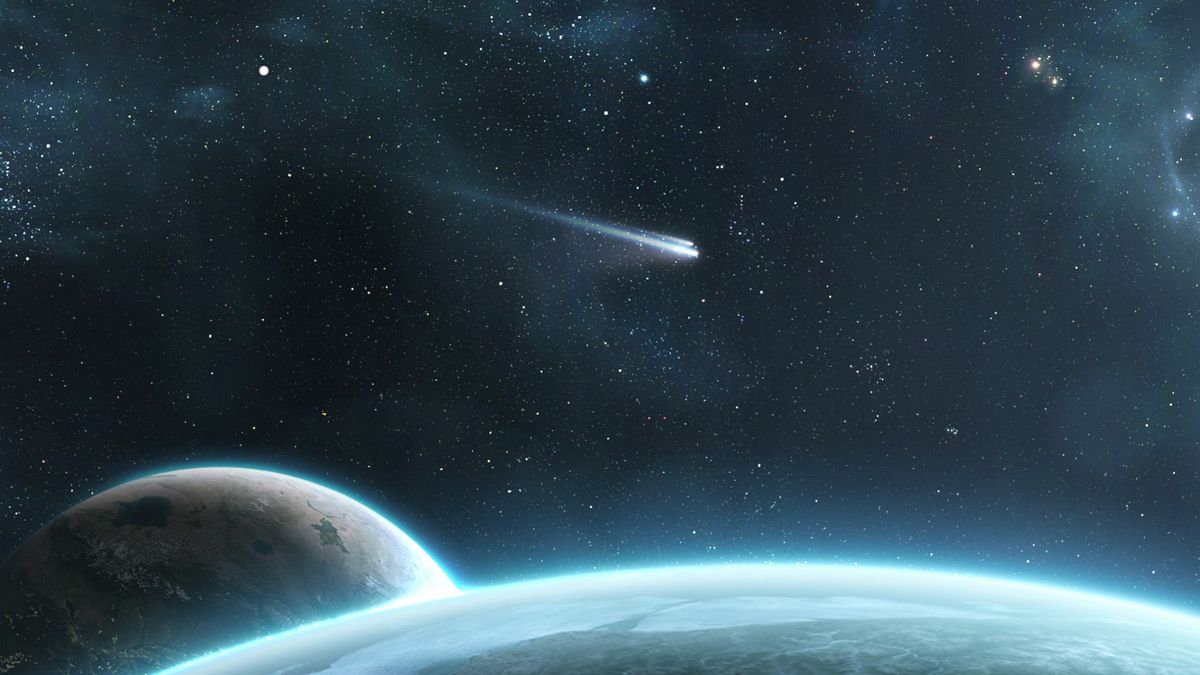
Scientists suspect that comets may have provided the organic ingredients needed for life to arise on Earth, and new research shows how exoplanets could receive these special supplies from comets, too.
In its early history, Earth was bombarded by asteroids, comets, and other cosmic bodies left over from the formation of the solar system. Scientists are still debating how the planet obtained the water and molecules needed to form life, but comets are likely candidates.
But if comets could have delivered the seeds of life to Earth, could they do the same for exoplanets elsewhere in the universe? With this question in mind, a team of researchers from the University of Cambridge’s Institute of Astronomy developed mathematical models that helped them show how comets could theoretically provide similar building blocks of life to other planets in the Milky Way.
While the research is far from definitive proof of life on other worlds, the team’s findings could help narrow the search for exoplanets that host life.
“We’re learning more about exoplanet atmospheres all the time, so we wanted to find out if there were planets where complex molecules could also be reached by comets,” study author Richard Anslow of the University of Cambridge’s Institute of Astronomy said in an article. statement. “It is possible that the molecules that gave rise to life on Earth came from comets, so the same could be true for planets elsewhere in the galaxy.”
Related: Comet 67P contains the essential elements for life, smelling like mothballs and almonds
In the past few decades, scientists have learned more about so-called “prebiotic molecules” found inside comets that could give rise to life. For example, in 2009, samples were obtained from Comet Wild 2 during a NASA mission Stardust The mission was found to contain glycine, an amino acid and building block of protein. European Space Agency Rashid The mission also detected organic molecules in the atmosphere of comet 67P/Churyumov-Gerasimenko between 2014 and 2016.
But these organic molecules may be destroyed during a collision with a planet at high speed and high temperature. This meant that Anslow and his colleagues had to find scenarios in which a comet’s collision with another solar system would be slow enough for these essential components of life to remain intact.
Through their simulations, the researchers found that for solar systems containing stars similar to the Sun, the lowest-velocity impacts would be most likely in places where multiple planets are tightly packed together. Scientists have called these types of planetary systems “Pea systems in pods“A comet traveling from the outer edges of such a system would slow down as it bounced between the orbits of these planets.
Meanwhile, the team’s simulations suggest there may be “unique challenges for life” on the surrounding rocky planets Red dwarf starsofficially known as M dwarf stars. These are the most common stars in the galaxy and have been a popular target for astronomers searching for exoplanets.
But rocky planets in such a system also experience more high-speed impacts. A comet’s chance of seeding life there may be doomed, especially if the planets are more widely spaced.
“It is exciting that we can begin to determine what type of systems we can use to test different asset scenarios,” Anslow said in a statement. “It’s a different way of looking at the great work that has already been done on Earth. What are the molecular pathways that have led to the enormous diversity of life we see around us? Are there other planets with the same pathways? It’s an exciting time, to be able to ‘combine advances. in astronomy and chemistry to study some of the most fundamental questions of all.”
This was research Published today In the Proceedings of the Royal Society A.

“Web maven. Infuriatingly humble beer geek. Bacon fanatic. Typical creator. Music expert.”





More Stories
Scientists confirm that monkeys do not have time to write Shakespeare: ScienceAlert
SpaceX launches 23 Starlink satellites from Florida (video and photos)
A new 3D map reveals strange, glowing filaments surrounding the supernova